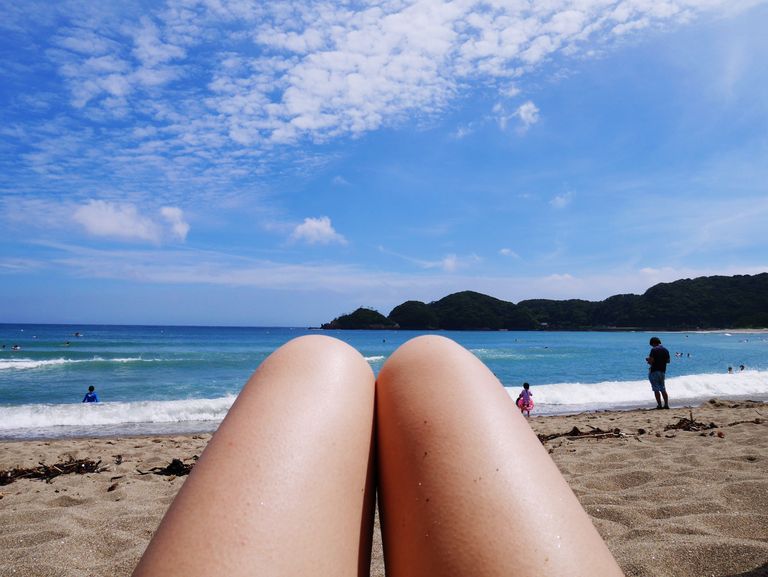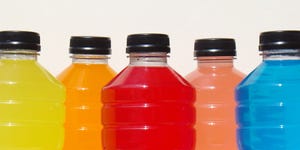
Let’s get something out of the way first: There’s nothing you can do to spot-reduce fat on your thighs—or anywhere on your body, TBH.
That’s because losing fat is kind of an all or nothing approach. “You can reduce your overall body fat by eating healthy and exercising, but your body doesn’t know where it’s burning fat,” says Lisa Moskovitz, R.D., CEO of NY Nutrition Group. “Wherever there’s fat on your body, it will come off. And we have fat all over our bodies.”
I know, not exactly what you want to hear. But there are a few steps you can take to de-bloat and tone your legs while losing weight all over.
1. Watch your salt intake.
Salt makes your body retain excess water that bloats your whole body, hips and thighs included. “Water follows salt, so the more you eat, the more water gets stored instead of being filtered out by your kidneys,” says Moskovitz. “By cutting back, you’ll notice almost an immediate change in how you feel and how your clothes fit.”
Per the American Heart Association’s recommendations, most people need 2,300 milligrams of sodium per day—but many of us are getting way more than that. Cut back by limiting processed foods, like sauces, canned veggies, and soups, which are often loaded with sodium.
2. Add more electrolytes into your diet.
You’ve seen them in sports drinks, but electrolytes like calcium, magnesium, and potassium are plentiful in many healthy foods that might already be in your diet.
All of them—and potassium, in particular—compete with salt. “The more [electrolytes] that you have, the less salt your body will retain,” says Moskovitz. “It helps keep the fluid balance stable, so your body flushes out water retention,”
Dark leafy greens, yogurt, and bananas are excellent sources of various types of electrolytes. Moskovitz says everyone should aim for nine servings of fruits and veggies every day: two to three half-cup servings of fruit, and the rest veggies (one cup raw or one-half cup cooked).
3. Cut back on carbs.
When your body transforms carbs into glycogen, it’s stored with water in your liver and muscle. That means the more carbs you eat, the more water your body stores. “That’s why a lot of people find they lose a few pounds immediately on low-carb diet. A lot of that is water weight,” says Moskovitz.
She suggests getting a minimum of 75 to 100 grams of carbs per day, although some people might need quite a bit more depending on their height, weight, and activity level.
Just don’t skip whole grains altogether, since they’re an excellent source of filling, heart-healthy fiber as well as folate, iron, magnesium, antioxidants, and phytonutrients. If you’re not sure of your carb sweet spot, check with a nutritionist.
4. Start your morning with a cup of coffee.
Coffee has a very mild diuretic effect and may stimulate your metabolism, your body’s fat-burning ability, and even boost your workouts. That said, there is such a thing as too much coffee. “It can lead to crashes that contribute to overeating at night and generally not feeling great,” says Moskovitz. She suggests sticking to two cups per day max.
5. Carry a water bottle around with you.
It seems counterintuitive, but the less water you drink, the more your body holds onto it. Drinking plenty of water flushes out the excess salt and fluids your body doesn’t need, reducing bloating.
It also helps curb your appetite, since dehydration mimics hunger. Moskovitz suggests aiming for two to three liters per day, on the higher end if you’re exercising or it’s hot outside.
6. Sweat it out
Aerobic exercise is another way flush out excess salt and fluids. What’s more, any activity that gets your heart rate up is also your best bet to spend calories and burn body fat—including on your hips and thighs.
But remember to stay hydrated. Aim to drink 16 to 20 ounces more water per hour of intense exercise and eat extra foods with electrolytes if you’re hitting the pavement for more than an hour.
7. Try tracking your meals.
Keeping daily records of every single food you put in your mouth helps you stay on track and accountable when you’re trying to shed body fat. Moskovitz likes the app MyFitnessPal, since it’s easy to use and has estimates for most foods (but plain old pen-and-paper works fine, too).
Keeping tabs on your diet also means planning your meals ahead of time as often as possible. “Life gets in the way and it’s hard to stay on track, so having your meals planned out helps for sure,” says Moskovitz.
8. Eat more fiber and protein.
Pack every meal with fiber and protein to boost weight loss, since both macronutrients help keep you fuller on fewer calories.
Protein, in particular, is essential for building the lean muscle that will make your legs look great. Moskovitz suggests trying for a total of 25 to 35 grams of fiber and 75 to 100 grams of protein per day from veggies, fruits, whole grains, and lean meats.
9. Spot-train your thighs
While you can’t spot-reduce thigh fat, you can spot-train your muscles so they’re toned and strong.
Target your thighs all over by doing curtsy lunges, sumo squats, and goblet squats. Focus on your inner and outer thighs with lateral lunges and band leg side raises; and hit your hamstrings with deadlifts, reverse leg curls, and bridges with hamstring curls.
Choose your favorite exercises from each group and complete each for eight to 12 reps at your maximum weight for a total of three to four sets. Ideally, try for two days of leg workouts each week, mixing multi-muscle compound movements (think squats and lunges) with more targeted exercises (like bridges and hamstring curls).
Source: Read Full Article

